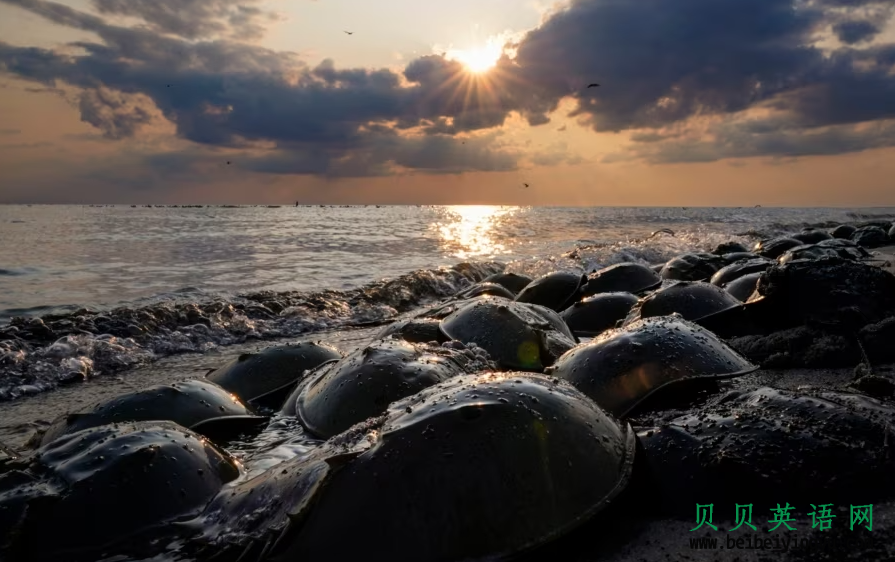欢迎访问贝贝英语网!
VOA慢速英语听力:保护珍贵马蹄蟹的新规定 New Rules Aim to Protect Valuable Horseshoe Crabs.
New rules aim to protect horseshoe crabs, which are used in medical research, and also to support an endangered bird species.
Blue blood from horseshoe crabs is used by researchers to test for dangerous substances in vaccines, medicines and medical devices. The animals are also used by fisherman as bait to catch eels and sea snails.
In addition, the eggs of horseshoe crabs are an important food for an endangered bird called the red knot.
Scientists say horseshoe crabs have been living in ocean environments for more than 400 million years. But they are different from other crabs. They are more closely related to spiders and scorpions. The animals have been decreasing in numbers in areas they live in, called habitats, along the U.S. East Coast.
The blue blood is taken from the animals for medical research. The process returns the crabs to the environment. But many die from the blood harvesting process.

Blood from the crabs can be manufactured into limulus amebocyte lysate, or LAL, a substance used to identify dangerous substances in some medications and vaccines.
Fishermen collect the crabs by hand or with special equipment on boats for use by biomedical companies. The blood – which contains immune cells sensitive to bacteria – is then separated and proteins are processed. It takes many crabs to produce enough blood to fill a single glass tube, which contains cells that are sensitive to bacteria.
New guidelines for dealing with horseshoe crabs were approved in May by the Atlantic States Marine Fisheries Commission. Industry officials said those changes should keep more crabs alive. But, in recent years, environmentalists brought attention to the issue of the horseshoe crabs, including their relationship to the red knot.
Red knots are birds that travel about 30,500 kilometers back and forth from South America to Canada. During their long trip, the birds must stop to eat along the way and horseshoe crabs are an important food.
Bethany Kraft is a coastal conservation specialist with the environmental organization the Audubon Society. Kraft told The Associated Press (AP) that red knots need horseshoe crab eggs to give them enough fuel to complete their long flights. “There's very clear linkage between horseshoe crabs and the survival of the red knot in the coming decades,” she added.
Kraft said horseshoe crabs currently need stronger protection to survive. She and other wildlife conservationists have noted the new guidelines are currently only voluntary. This, they say, still leaves the red knot at risk. They say the bird needs stronger legal protection.
The new guidelines urge best practices for the biomedical industry's harvesting and processing of the crabs. They include measures aimed at limiting exposure to sunlight and keeping crabs cool and wet.
Caitlin Starks is a fishery specialist with the Atlantic States Marine Fisheries Commission. She told the AP the goal of the guidelines “is to give the crabs that are bled a better chance of surviving.”
That is exactly what the new guidelines will do, said Nora Blair, an operations official with Charles River Laboratories. The company manufactures LAL from horseshoe crab blood. Blair was a member of a working group that created the new guidelines along with other industry groups.
Blair said the industry is working to find synthetic materials that could be used for biomedical research. Conservationists have been pushing for years for such a solution. Lonza, a Switzerland-based company that manufactures LAL, offers an animal-free testing solution.
But Blair said that, for now, the wild harvest of horseshoe crabs remains extremely important for drug safety. The animals play an important part in supplying and testing drugs and the coastal environment makes their conservation “imperative,” she added.
I’m Bryan Lynn.
新规定旨在保护用于医学研究的蛤蟆,同时也支持一种濒危的鸟类物种。
蛤蟆的蓝色血液被研究人员用来测试疫苗、药物和医疗设备中的危险物质。渔民也将这些动物用作捕捉鳗鱼和海蜗牛的饵料。
此外,蛤蟆的卵是一种叫做红结蛤鹬的濒危鸟类的重要食物。
科学家表示,蛤蟆在海洋环境中生活了超过4亿年。但它们与其他螃蟹不同,它们与蜘蛛和蝎子的关系更密切。这些动物在美国东海岸沿线的栖息地数量有所减少。
这些蓝色血液被用于医学研究。该过程将蟹类放回环境中。但是,许多蟹在采血过程中死亡。
蛤蟆的血液可以制成贝胞激活物溶菌试剂(LAL),这是一种用于识别一些药物和疫苗中的危险物质的物质。
渔民用手或特殊设备在船上收集蟹类供生物医学公司使用。然后将包含对细菌敏感的免疫细胞的血液分离并加工。需要很多蟹才能产生足够的血液来填充一个玻璃管,其中含有对细菌敏感的细胞。
新的蛤蟆处理指南于五月份由大西洋州海洋渔业委员会批准。行业官员表示,这些变化应该会使更多的蟹得以幸存。但近年来,环保人士引起了对蛤蟆问题的关注,包括它们与红结蛤鹬的关系。
红结蛤鹬是一种从南美洲到加拿大来回旅行约30500公里的鸟类。在它们漫长的旅程中,这些鸟必须在途中停下来进食,而蛤蟆是它们的重要食物。
伯大尼·克拉夫特是环保组织奥杜邦协会的沿海保护专家。克拉夫特告诉美联社(AP)说,红结蛤鹬需要蛤蟆的卵来提供足够的能量完成它们的漫长飞行。她补充说:“蛤蟆和红结蛤鹬在未来几十年的生存之间有着非常明确的联系。”
克拉夫特表示,目前蛤蟆需要更强有力的保护措施来幸存。她和其他野生动植物保护人士指出,新的指南目前仅是自愿性的。他们说,这仍然会让红结蛤鹬处于风险之中。他们表示,这种鸟需要更强的法律保护。
新的指南敦促生物医学行业在采集和加工蛤蟆时采用最佳实践。其中包括旨在限制暴露于阳光和保持蟹类湿润和凉爽的措施
。
凯特琳·斯塔克斯是大西洋州海洋渔业委员会的渔业专家。她告诉美联社(AP)指南的目标是“为被采血的蟹类提供更好的幸存机会。”
查尔斯·里弗实验室的运营官诺拉·布莱尔表示,新的指南将做到这一点。该公司从蛤蟆的血液中制造贝胞激活物溶菌试剂。布莱尔是一个由其他行业团体与之共同制定新指南的工作小组的成员。
布莱尔表示,目前,蛤蟆的野外收获对于药物安全来说仍然非常重要。这些动物在提供和测试药物方面发挥着重要作用,而沿海环境使得它们的保护“至关重要”。
Words in This Story
species – n. a group of animals or plants that are similar and can produce young animals or plants
bait –n. a piece of foot that is used to catch fish or other animals
conservation – n. an organized effort that aims to protect animals, and natural resources
decade – n. a period of ten years
expose – v. to remove what is covering something so that it can be seen
synthetic – adj. a group of products made from artificial substances, often copying a natural product
imperative – adj. extremely important or necessary